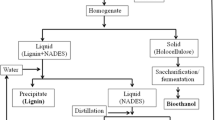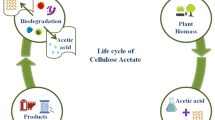Abstract
Bacterial cellulose (BC) has extensive application prospects in many fields in view of its unique characteristics. However, the large-scale applications of BC are severely limited because of relatively low BC productivity and high cost of culture medium. Herein, the distiller’s grain enzymatic hydrolysate (DEH) and yellow water were successfully combined as an effective substitute (the best distiller’s grains–yellow water medium, BDY medium) for traditional Hestrin–Schramm medium (HS medium) for BC production by Gluconacetobacter xylinus through the response surface methodology. The BC production in BDY medium was significantly enhanced to 7.42 g/l with BC conversion yield of 42.4% after 7 days static cultivation, which was 3.72-fold and 3.37-fold higher than that in HS medium, respectively. The structure and properties of BC membranes produced in HS and BDY medium were evaluated by X-ray diffraction (XRD), Fourier transform infrared spectroscopy (FT-IR), field emission scanning electron microscopy (FE-SEM), thermogravimetric analysis (TGA) and hydrophilicity analysis. There was no significant difference between BC samples produced in the HS and BDY medium, indicating that BDY, as abundant and inexpensive substrates, can effectively replace HS medium to enhance BC production. The employment of distiller’s grains and yellow water to BC production not only is conducive to achieve industrial production of BC, but also can effectively realize the recycling of waste from Baijiu distillery.






Similar content being viewed by others
References
Huang Y, Zhu C, Yang J, Nie Y, Chen C, Sun D (2014) Recent advances in bacterial cellulose. Cellulose 21:1–30
Singhsa P, Narain R, Manuspiya H (2018) Physical structure variations of bacterial cellulose produced by different Komagataeibacter xylinus strains and carbon sources in static and agitated conditions. Cellulose 25:1–11
Li Z, Wang LF, Hua JC, Jia SR, Zhan JF, Liu H (2015) Production of nano bacterial cellulose from waste water of candied jujube-processing industry using Acetobacter xylinum. Carbohydr Polym 120:115–119
Pacheco G, Nogueira CR, Meneguin AB, Silva MCC, Trovatti E, Machado RTA et al (2017) Development and characterization of bacterial cellulose produced by cashew tree residues as alternative carbon source. Ind Crops Prod 107:13–19
Ashori A, Sheykhnazari S, Tabarsa T, Shakeri A, Golalipour M (2012) Bacterial cellulose/silica nanocomposites: preparation and characterization. Carbohydr Polym 90:413–418
Dayal MS, Goswami N, Sahai A, Jain V, Mathur G, Mathur A (2013) Effect of media components on cell growth and bacterial cellulose production from Acetobacteraceti MTCC 2623. Carbohydr Polym 94:12–16
Di Z, Shi Z, Ullah MW, Li S, Yang G (2017) A transparent wound dressing based on bacterial cellulose whisker and poly (2-hydroxyethyl methacrylate). Int J Biol Macromol 105:638–644
Fu L, Zhang J, Yang G (2013) Present status and applications of bacterial cellulose-based materials for skin tissue repair. Carbohydr Polym 92:1432–1442
Helenius G, Bäckdahl H, Bodin A, Nannmark U, Gatenholm P, Risberg B (2010) In vivo biocompatibility of bacterial cellulose. J Biomed Mater Res Part A 76A:431–438
Esa F, Tasirin SM, Rahman NA (2014) Overview of bacterial cellulose production and application. Agric Agric Sci Procedia 2:113–119
Velasquez-Riano M, Bojaca V (2017) Production of bacterial cellulose from alternative low-cost substrates. Cellulose 24:2677–2698
Cheng Z, Yang R, Liu X, Liu X, Chen H (2017) Green synthesis of bacterial cellulose via acetic acid pre-hydrolysis liquor of agricultural corn stalk used as carbon source. Biores Technol 234:8–14
Kurosumi A, Sasaki C, Yamashita Y, Nakamura Y (2009) Utilization of various fruit juices as carbon source for production of bacterial cellulose by Acetobacter xylinum NBRC 13693. Carbohydr Polym 76:333–335
Wu JM, Liu RH (2012) Thin stillage supplementation greatly enhances bacterial cellulose production by Gluconacetobacter xylinus. Carbohydr Polym 90(1):116–121
Hong F, Zhu YX, Yang G et al (2011) Wheat straw acid hydrolysate as a potential cost-effective feedstock for production of bacterial cellulose. J Chem Technol Biotechnol 86(5):675–680
Vazquez A, Foresti ML, Cerrutti P, Galvagno M (2013) Bacterial Cellulose from simple and low cost production media by Gluconacetobacter xylinus. J Polym Env 21:545–554
Zuo SC, Yang HQ, Zou W (2016) Research progress on the utilization of distiller's grains as resources. Food Ind 37:246–249
Wang ZG, Wei YL, Wei MS, Wang XL, Xiang D (2008) Effect of organic acids on bacterial cellulose production in defined medium by Acetobater xylinum. Food Sci 29:295–297
Zhang LP, Lu HM, Dai R, Dai LX, Jiang XL (2014) Study on the function of ethanol and organic acids to Acetobacter xylinum synthetic bacterial cellulose. Food Ind Sci Technol 35:161–165
Hestrin S, Schramm M (1954) Synthesis of cellulose by Acetobacter xylinum. II. Preparation of freeze-dried cells capable of polymerizing glucose to cellulose. Biochem J 58:345–352
Erbas Kiziltas E, Kiziltas A, Gardner DJ (2015) Synthesis of bacterial cellulose using hot water extracted wood sugars. Carbohydr Polym 124:131–138
Lever M (1977) Carbohydrate determination with 4-hydroxybenzoic acid hydrazide (PAHBAH): effect of bismuth on the reaction. Anal Biochem 81:21–27
Du R, Zhao F, Peng Q, Zhou ZJ, Han Y (2018) Production and characterization of bacterial cellulose produced by Gluconacetobacter xylinus isolated from chinese persimmon vinegar. Carbohydr Polym 194:20–207
Żywicka A, Junka AF, Szymczyk P, Chodaczek G, Grzesiak J, Sedghizadeh PP et al (2018) Bacterial cellulose yield increased over 500% by supplementation of medium with vegetable oil. Carbohydr Polym 199:294–303
Huang C, Yang XY, Xiong L, Guo HJ, Luo J et al (2015) Evaluating the possibility of using acetone-butanol-ethanol (ABE) fermentation wastewater for bacterial cellulose production by Gluconacetobacter xylinus. Lett Appl Microbiol 60:491–496
Qi GX, Luo MT, Huang C et al (2017) Comparison of bacterial cellulose production by\r, Gluconacetobacter xylinus on bagasse acid and enzymatic hydrolysates. J Appl Polym Sci 134:45066
Yang Y, Jia J, Xing J, Chen J, Lu S (2013) Isolation and characteristics analysis of a novel high bacterial cellulose producing strain Gluconacetobacter intermedius Cis26. Carbohydr Polym 92:2012–2017
Masaoka S, Ohe T, Sakota N (1993) Production of cellulose from glucose by Acetobacter xylinum. J Ferment Bioeng 75:18–22
Embuscado ME, Marks JS, Bemiller JN (1994) Bacterial cellulose. I. Factors affecting the production of cellulose by Acetobacter xylinum. Food Hydrocolloids 8:407–418
Jung HI, Jeong JH, Lee OM, Park GT, Kim KK, Park HC et al (2010) Influence of glycerol on production and structural–physical properties of cellulose from Acetobacter sp. V6 cultured in shake flasks. Biores Technol 101:3602–3608
Kuo CH, Chen JH, Liou BK, Lee CK (2015) Utilization of acetate buffer to improve bacterial cellulose production by Gluconacetobacter xylinus. Food Hydrocolloids 53:98–103
Zhang LP, Lu HM, Dai R, Dai LX, Jiang XL (2014) Study on the function of ethanol and organic acid to Acetobacter xylinus synthetic bacterial cellulose. Sci Technol Food Ind 35:161–165
Stumpf TR, Pértile RAN, Rambo CR, Porto LM (2013) Enriched glucose and dextrin mannitol-based media modulates fibroblast behavior on bacterial cellulose membranes. Mater Sci Eng C 33:4739–4745
Ul-Islam M, Ha JH, Khan T, Park JK (2013) Effects of glucuronic acid oligomers on the production, structure and properties of bacterial cellulose. Carbohydr Polym 92:360–366
Castro C, Zuluaga R, Alvarez C, Putaux JL, Caro G, Rojas OJ et al (2012) Bacterial cellulose produced by a new acid-resistant strain of Gluconacetobacter genus. Carbohydr Polym 89:1033–1037
Tokoh C, Takabe K, Fujita M, Saiki H (1998) Cellulose synthesized by Acetobacter xylinum in the presence of acetyl glucomannan. Cellulose 5:249–261
Wu JM, Liu RH (2013) Cost-effective production of bacterial cellulose in static cultures using distillery wastewater. J Biosci Bioeng 115:284–290
Barud HS, Araújo Júnior AM, Santos DB, Assuncao RMN, Meireles CS, Cerqueira DA et al (2008) Thermal behavior of cellulose acetate produced from homogeneous acetylation of bacterial cellulose. Thermochim Acta 471:61–69
Mohammadkazemi F, Azin M, Ashori A (2015) Production of bacterial cellulose using different carbon sources and culture media. Carbohydr Polym 117:518–523
Zeng ML, Laromaine A, Roig A (2014) Bacterial cellulose films: influence of bacterial strain and drying route on film properties. Cellulose 21:4455–4469
Re ZQ, Zhang DJ (2017) Effect of drying methods on structure and properties of bacterial cellulose membrane. Sci Technol Food Ind 38:91–96
Acknowledgements
Jiuhai Legendary Wine Co., Ltd is acknowledged for the financial support of the Brewing Science and Technology Cooperation Project (17A0331-SCU) for this study. The authors would like to acknowledge the contributions of the Analytical & Testing Center of Sichuan University.
Author information
Authors and Affiliations
Corresponding author
Ethics declarations
Conflict of interest
The authors report no conflict of interest.
Additional information
Publisher's Note
Springer Nature remains neutral with regard to jurisdictional claims in published maps and institutional affiliations.
Rights and permissions
About this article
Cite this article
He, F., Yang, H., Zeng, L. et al. Production and characterization of bacterial cellulose obtained by Gluconacetobacter xylinus utilizing the by-products from Baijiu production. Bioprocess Biosyst Eng 43, 927–936 (2020). https://doi.org/10.1007/s00449-020-02289-6
Received:
Accepted:
Published:
Issue Date:
DOI: https://doi.org/10.1007/s00449-020-02289-6




